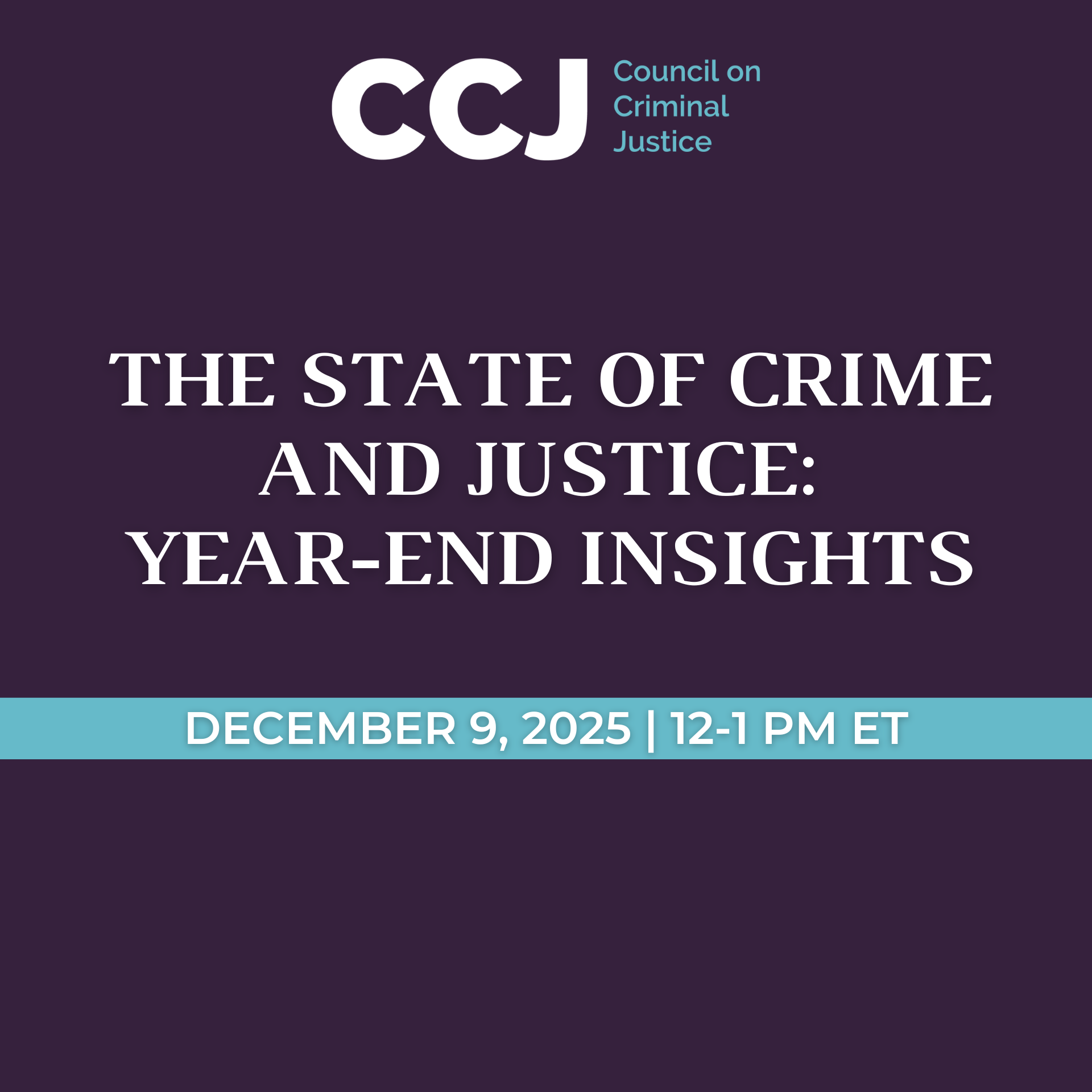At the Commission’s first meeting, experts from the Urban-Brookings Tax Policy Center and the Urban Institute’s Justice Policy Center briefed Commissioners on how the coronavirus pandemic is shaping public budgets nationwide. Read their analysis – and how policymakers can avoid past mistakes – below.
This report examines changes in crime rates in 34 American cities since the start of the COVID-19 pandemic in 2020, with a special emphasis on homicide and other violent crimes. The current study updates previous studies by the authors with additional data through March 2021. The study was conducted by criminologist and Professor Emeritus Richard Rosenfeld and Ernesto Lopez of the University of Missouri – St. Louis and Thomas Abt, Commission Director and Council on Criminal Justice Senior Fellow.
Criminal Justice Finance in the COVID-19 Recession and Beyond
Richard Auxier, Tracy Gordon, and Kim Rueben | Urban-Brookings Tax Policy CenterNancy La Vigne | Urban Institute Justice Policy Center
REPOSTED WITH PERMISSION
The COVID-19 pandemic and resulting recession are putting an enormous strain on state and local governments.
Beyond the well-known difficulties states and localities face in recessions and the challenges of managing a public health emergency, leaders managing this crisis must also contend with an upwelling of protest and discontent with the funding model for police and other criminal justice programs as well as rising violent crime in some communities.
But policymakers and advocates can turn these challenges into opportunities to enact lasting public safety reforms if they understand the nature and potential impacts of the current fiscal crisis, avoid the mistakes of the past, and focus on changes that are both equitable and effective.
To this end, the Council on Criminal Justice launched a National Commission on COVID-19 and Criminal Justice. A presentation we delivered at their kick-off meeting is summarized below.
The COVID-19 pandemic and resulting recession are putting an enormous strain on state and local governments.
Beyond the well-known difficulties states and localities face in recessions and the challenges of managing a public health emergency, leaders managing this crisis must also contend with an upwelling of protest and discontent with the funding model for police and other criminal justice programs as well as rising violent crime in some communities.
But policymakers and advocates can turn these challenges into opportunities to enact lasting public safety reforms if they understand the nature and potential impacts of the current fiscal crisis, avoid the mistakes of the past, and focus on changes that are both equitable and effective.
To this end, the Council on Criminal Justice launched a National Commission on COVID-19 and Criminal Justice. A presentation we delivered at their kick-off meeting is summarized below.
Financing the Four Cs: cops, courts, corrections, and community-based programs
The major components of criminal justice are: cops (local and state police and sheriffs), courts (criminal courts, plus district attorneys and public defenders), and corrections (prisons, jails, probation, and parole). Community-based programs like Colorado’s Community Reentry program (reentry and rehabilitation) and the District of Columbia’s Cure the Streets program (violence prevention) are also an important component of public safety —and critical for innovation—but less comprehensive fiscal data are available for these programs.
Focusing on the first three Cs (cops, courts and corrections), state and local governments spent over $240 billion on these services in 2017 (the most recent year for which data are available): $114.5 billion on cops, $47.8 billion on courts (including civil courts), and $78.7 billion on corrections. The federal government spent $55 billion in 2016 (the most recent year federal data are available), but we will leave this spending out of this analysis as it is outside the hands of state and local policymakers.
Policing is mostly a local service. States spent $15.4 billion on police in 2017 (1.1 percent of all state direct general spending), while cities spent $62.9 billion (13.5 percent of city direct general spending).
And, while states spent more than counties on courts ($23.9 billion to $18.0 billion) and corrections ($48.8 billion to $25.0 billion) in 2017, each expenditure was a larger share of direct spending at the county than state level (1.7 percent to 4.6 percent and 3.4 percent to 6.4 percent). In sum, criminal justice spending is one of every five dollars spent at the county level, one in every six dollars spent at the city level, and one of every 20 dollars spent at the state level.
However, criminal justice spending varies significantly across jurisdictions. In some smaller localities, for example, spending on policing accounts for most of the budget. Meanwhile, New York City spent nearly $6 billion on policing in 2017 but that accounted for only 6 percent of its budget.
When looking at spending as a share of the budget across governments, the key difference is some (mostly smaller) governments provide only a few services while other (mostly larger) jurisdictions provide numerous services. In particular, if a city or county provides K-12 education (instead of an independent school district) its share of criminal justice spending will be a smaller share of its overall budget.
Further, localities overlap, and a community could be served by multiple criminal justice agencies. For example, Los Angeles city and county both spent over $2 billion on policing in 2017.
Nearly all spending on policing, courts, and corrections is current spending (e.g., salaries, training, and lab work) rather than capital spending (e.g., prison and court construction). And a majority of spending (current and capital) for each criminal justice expenditure goes exclusively to payroll. Thus, cost of living payments are a large reason why New York has higher per capita criminal justice expenditures than Kentucky.
The state and local COVID-19 fiscal crisis
States and cities went into the year with record high savings, but nothing could have prepared them for a downturn this abrupt and of this magnitude. More than 49 million Americans have filed initial claims for unemployment insurance since mid-March (more than during the entire Great Recession).
States project that their revenues will be $200 billion lower than expected at the start of the year—$75 billion in fiscal year 2020 and $125 billion in fiscal year 2021, or roughly 5 to 10 percent of all state own-source revenue. Past relationships between unemployment and government finances suggest that combined state and local budget shortfalls could go as high as $1 trillion over three years.
Further, the recession will also put pressure on the spending side of the budget, because of direct costs associated with COVID-19 as well as increased demands for services such as Medicaid and cash-assistance programs like Temporary Assistance for Needy Families.
Because state and local governments must balance their budgets, governments will have to increase taxes or cut spending. In fact, state and local governments have already eliminated 1.5 million public jobs since February, putting state and local public employment at a level not seen since 2001.
But more and deeper cuts are likely still on the way, especially if additional federal aid is not forthcoming. Governors from a range of diverse states—including Colorado, Kentucky, Ohio, Oregon, and Wyoming—are calling for across the board cuts exceeding 10 percent in current fiscal year.
Additionally, a National League of Cities survey found three-fourths of municipalities have already made spending cuts, with many resorting to across-the-board reductions. Miramar, Florida furloughed over 200 police officers. Westland, Michigan furloughed 137 workers, including several district court employees. “We’re spread pretty thin here,” said the mayor.
Cities such as Denver and Tulsa were able to avoid furloughing police officers during their first round of job cuts, but if the economic and fiscal situation does not improve soon these departments will become vulnerable. And while it’s difficult to learn from media reports how these large budget cuts affect smaller community-based programs, several cities have cut programs such as youth services that are akin to community-based safety and crime reduction programs.
Some of these worst-case budget scenarios may be avoided if the federal government provides additional aid to state and local governments. But if federal dollars are delayed or inadequate jurisdictions like California, which put off making large cuts when passing its current budget with hopes of federal support, may have to make midyear cuts. And, given protracted unemployment forecasts, this fiscal crisis will affect state and local governments for multiple years.
Going forward: Avoiding past mistakes and finding opportunity for reforms
The current fiscal crisis is daunting, but there are steps policymakers can take to mitigate problems and even embrace long-desired change.
Policymakers should first avoid past mistakes. For example, as revenues fell during the last recession, some localities turned to excessive fines and forfeitures, which had a particularly negative impact on low-income residents and communities of color. While Ferguson’s parasitic system was extreme, an overreliance on traffic violation fees can especially harm already under-resourced communities.
And if forced to cut, governments should avoid blunt instruments. Simply reducing criminal justice employees by seniority could reverse prior reforms aimed at diversifying the workforce. And cutting one department or agency without understanding the effects on another (i.e., siloing) could exacerbate future fiscal problems. For example, myopic cuts to the court system could slow down case processing, leading to jail crowding while detainees await dispositions and thus increasing corrections costs.
Then there are larger conversations about criminal justice reform. And while proposals for police reform span a continuum, one thing is clear: simply reducing spending across the board is not reform. Even with ample opportunities to shift funds across criminal justice programs, ultimately achieving reform goals could require more funding—just to different types of resources or programs.
Key among them should be community-based programs representing holistic, comprehensive approaches to public safety. Such programs exist that are evidence-based and relatively cheap in comparison to traditional crime control responses. In fact, fiscal austerity could prompt efforts to enhance investment in communities by providing more resources for community-led safety programs, better addressing underlying needs and equity gaps, and spurring local employment opportunities.
Ultimately, policymakers need to understand what drives budget costs and which policies effectively and equitably lower expenses.



